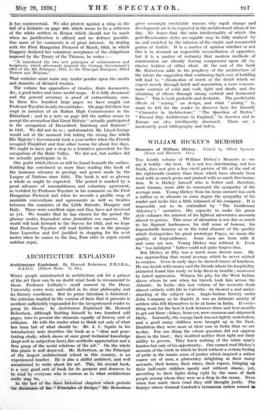ARCHITECTURE EXPLAINED
Architecture Explained. By Howard - Robertson, F.R.I.B.A., S.A.D.G. (Ernest Berm. 7s. 6d.)
WHEN people uninstructed in architecture ask for a primer of the art there can be no doubt what book to recommend to them. Professor Lethaby's small manual in the Home University series rests unrivalled in its clear philosophy and its literary excellence. _ But its prime intention is historical : the criticism implied' in the version of facts that it presents is nowhere sufffciently expounded for the inexperienced reader to grasp its theory. In Architecture Explciined Mr. Howard Robertson, although limiting himself to two hundred odd pages, tries to present the elements •equally, of history and of criticism. He tells the reader what to think not only of what has been but of what should - be. Mr. J. C: Squire in his introductory note describes the book as a " clear and pene- trating study, which shows at once great technical knowledge (kept well in subjection here), fine aesthetic appreciation and a firm grasp of the social relations of the art." On the whole this praiSe is well deserved. Mr. Robertson, as the Principal of the largest archifeetural school in this country, is an experienced teacher. He is also a skilful architect, and well accustomed to write about his art. This, his second book, is a very good sort of book for its purpose and deserves to be read by everyone who is curious as to what architecture really may be. In the last of the three historical chapters-which prelude his disetiSsien -of the Principles-Of. Design;"--Mr: Ttobertson gives seemingly irrefutable reasons why rapid change and development are to be expected in the architectural idiom of to- day. He hopes that the calm intellectuality of which the post-Renaissance styles are capable may be fully realized by us, and enriched by the infusion of the elastic and resourceful genius of Gothic. It is a matter of opinion whether or not this is to demand an impossible reconciliation of opposites, but it is a matter of certainty that modern methods of construction are already forcing compromise upon all ex- clusive holders of either ideal. At the end of the book Mr. Robertson adds to his prophecy of the architecture. of the future the suggestion that continuing high cost of buildMg will lead to " elimination of much of the detail which we expect merely through habit and association, a more consum- mate contrast of solid and void, light and shade, and the obtaining of effects through strong vertical and horizontal lines." This is both probable and desirable. The predictable effects of " zoning " on design, and what " zoning " is, must be left for the reader to discover- here for himself. " Character in Architecture," " The Question of Stylea," " Present Day Architecture in England," in America and in Europe are also intelligently discussed. There are a moderately good bibliography and index.










































 Previous page
Previous page